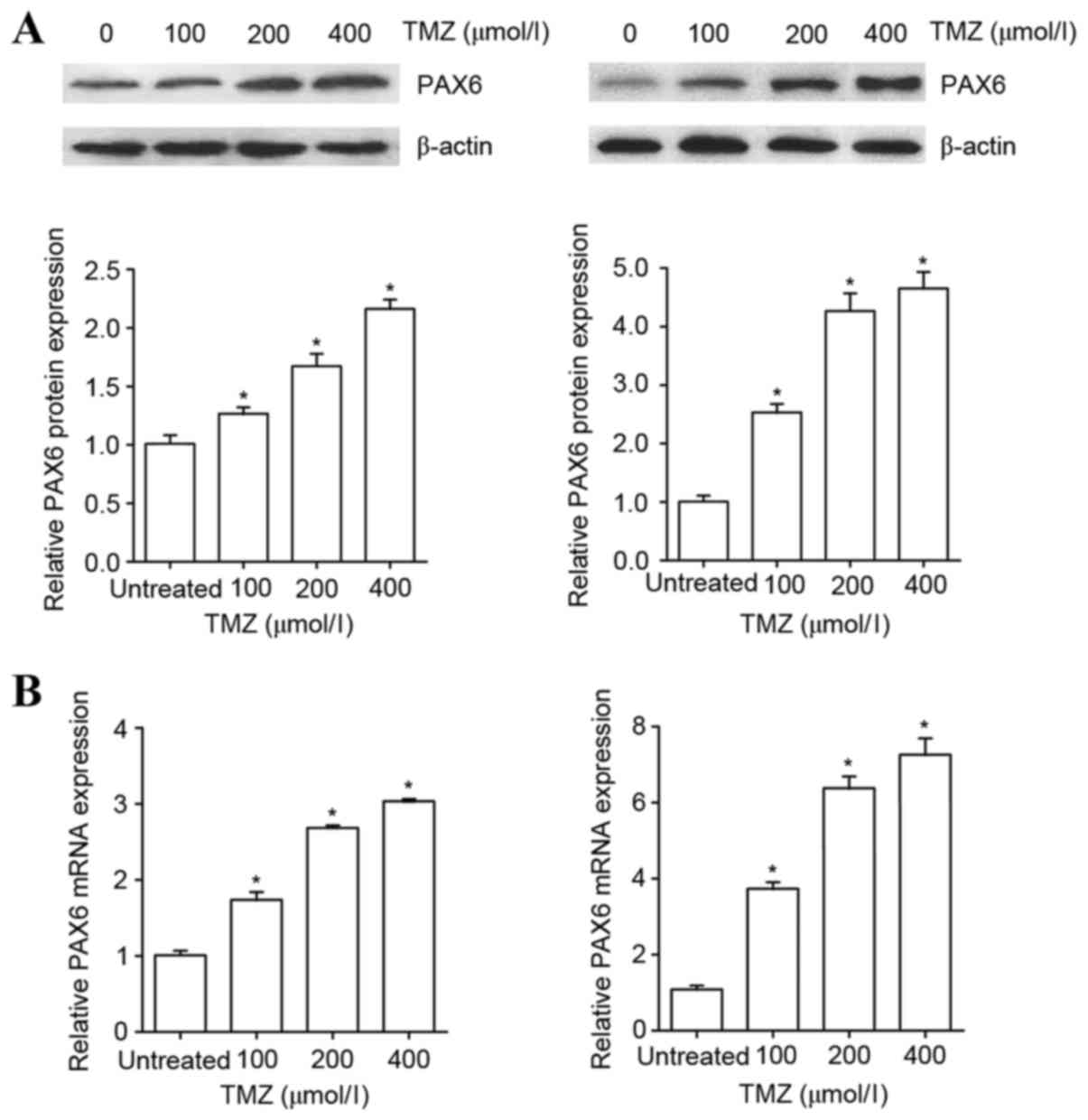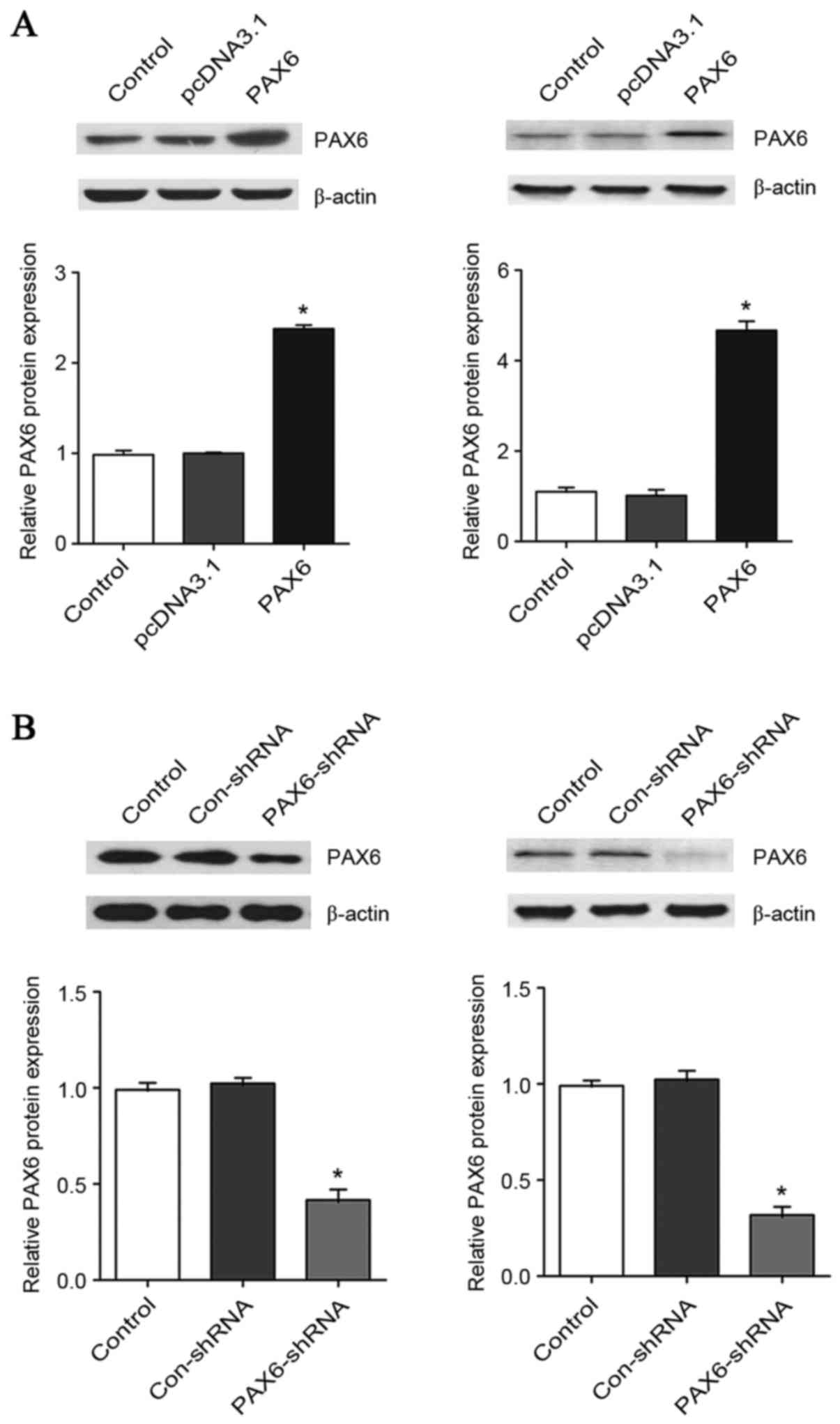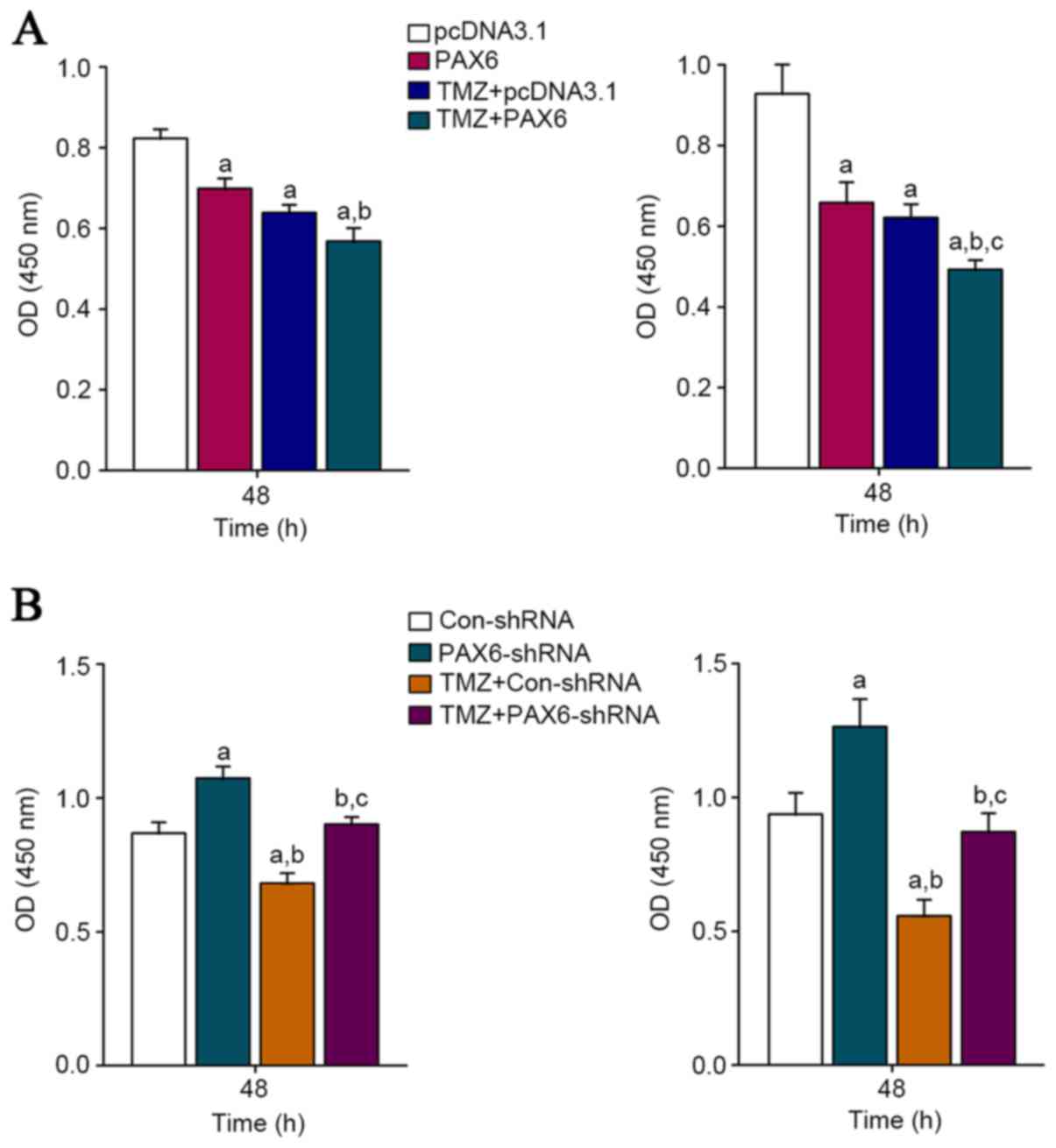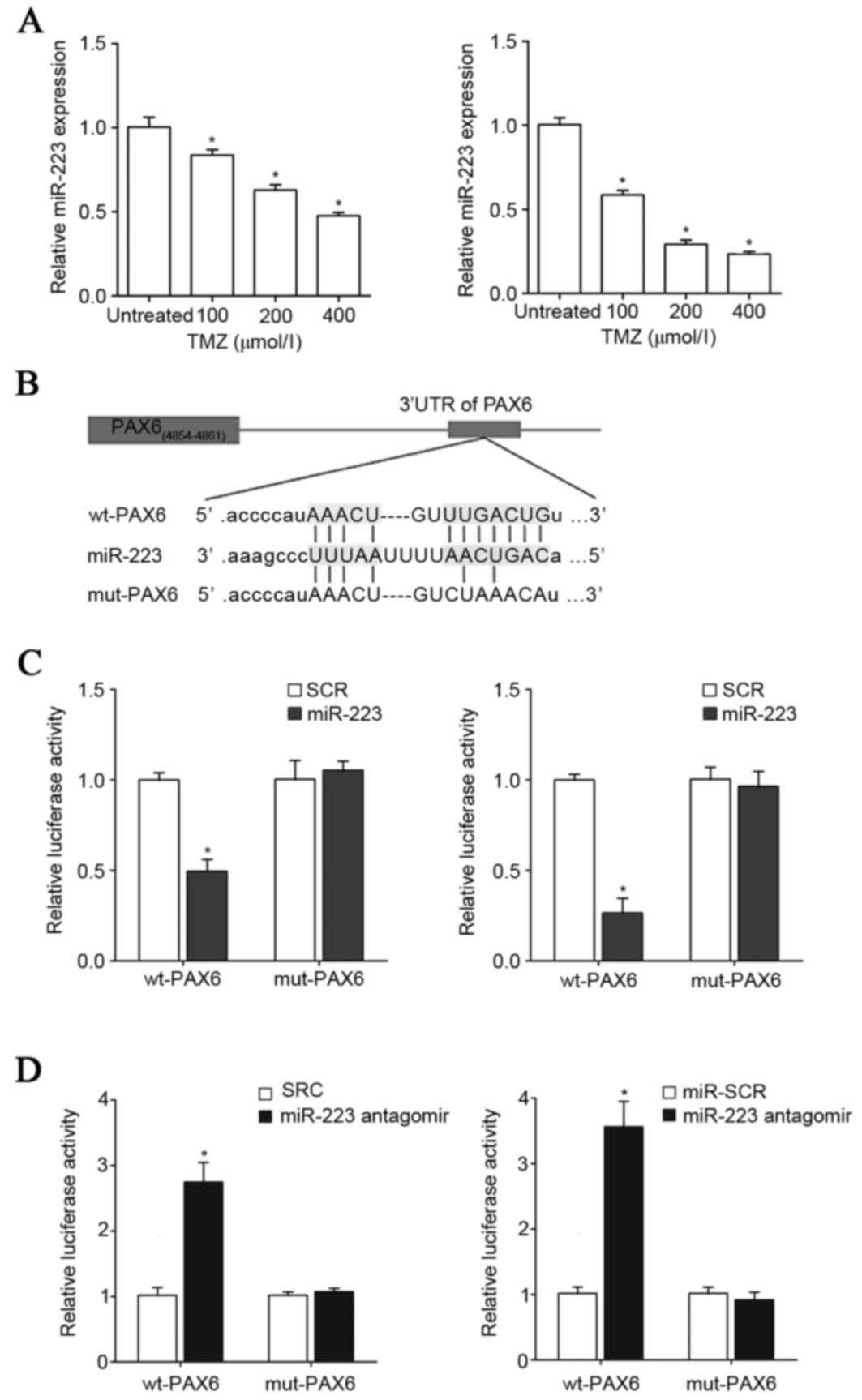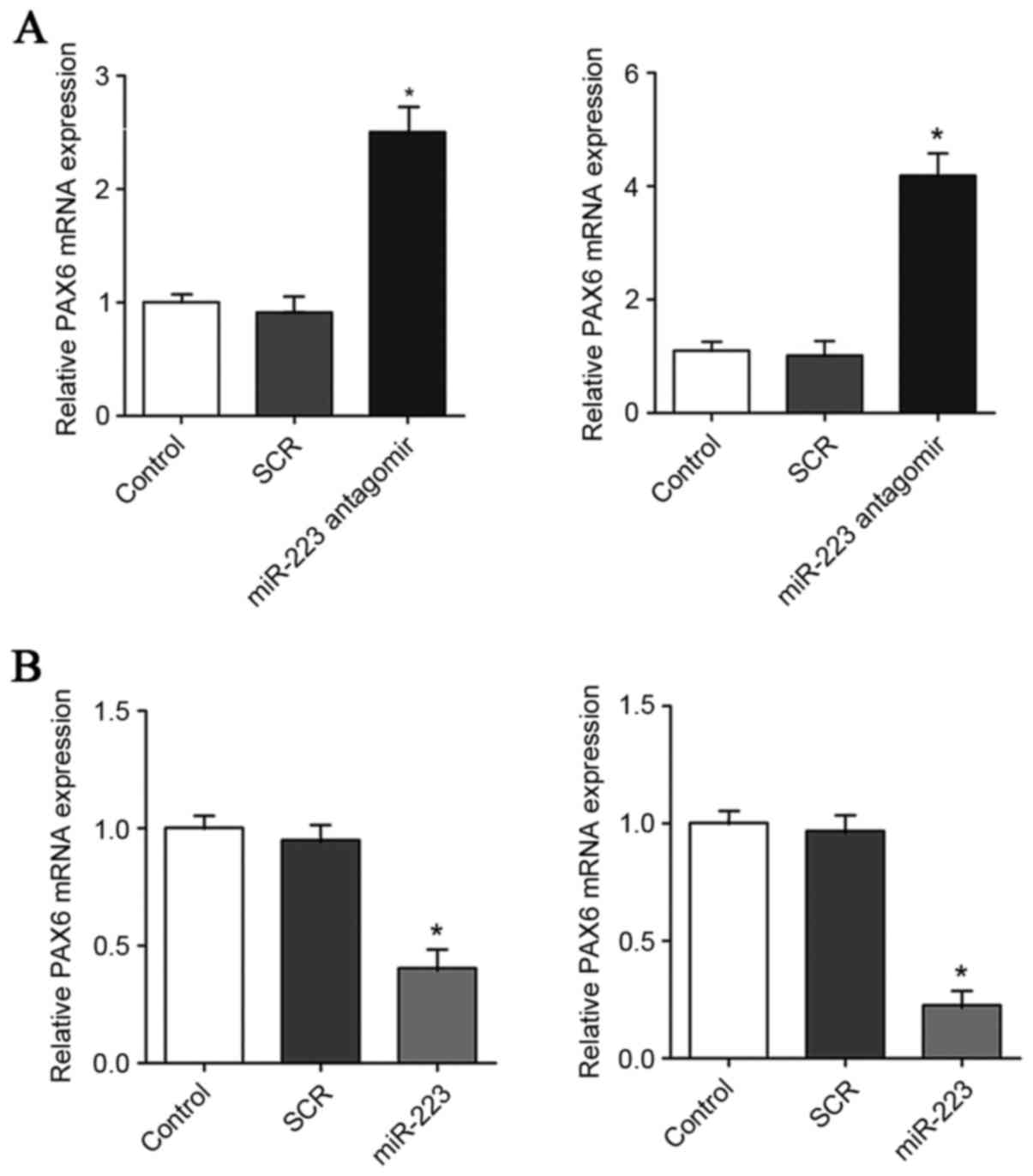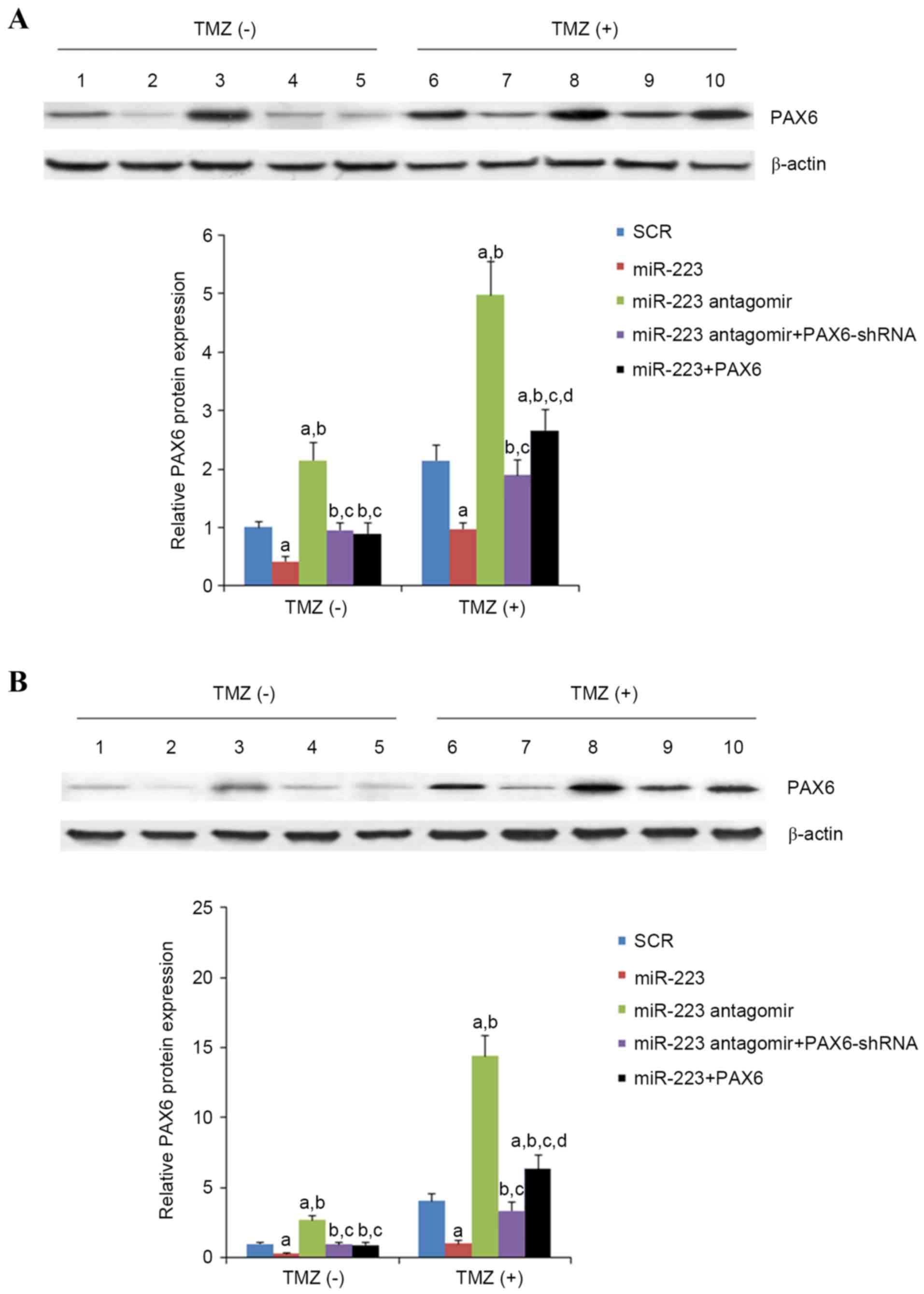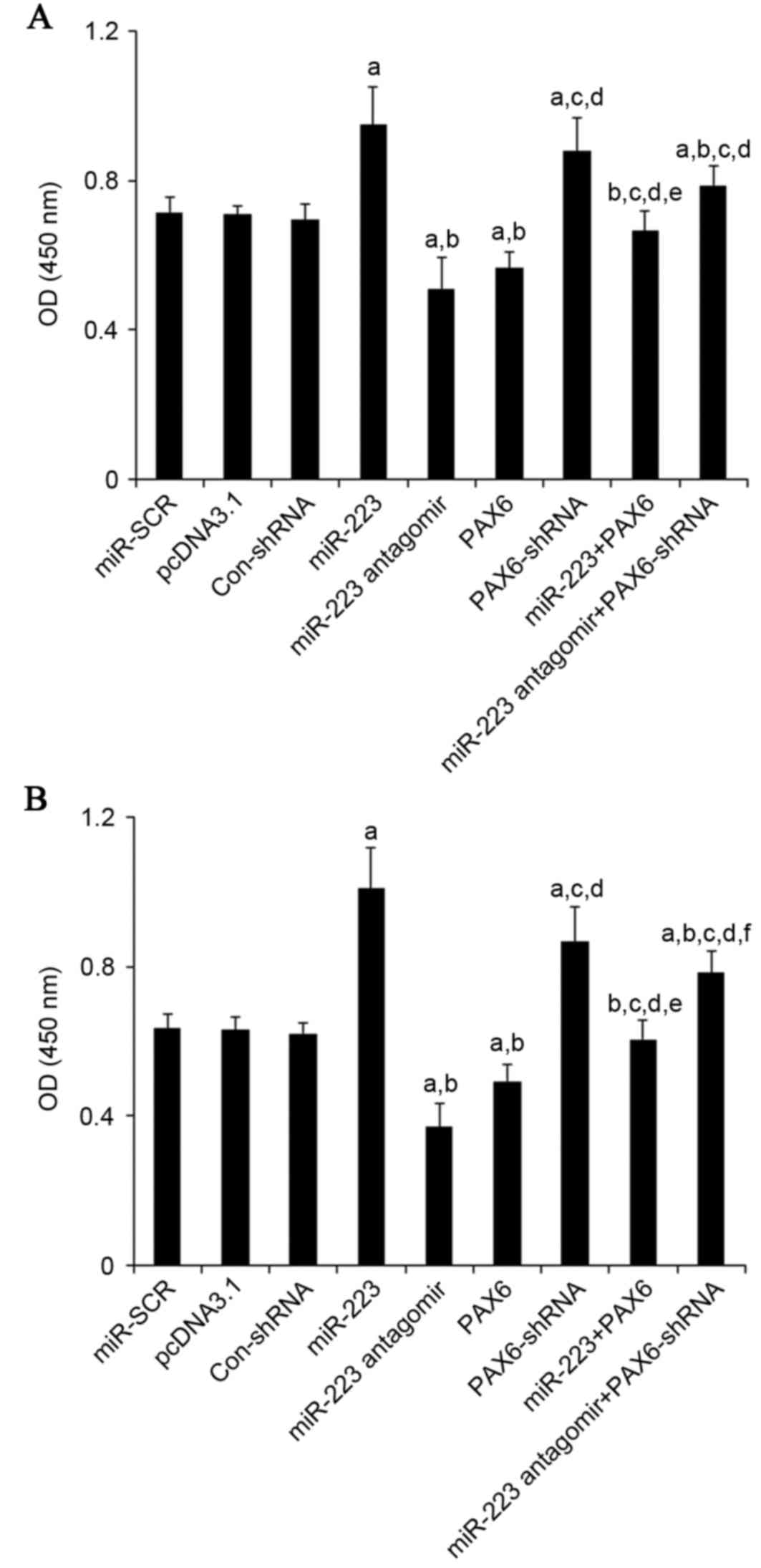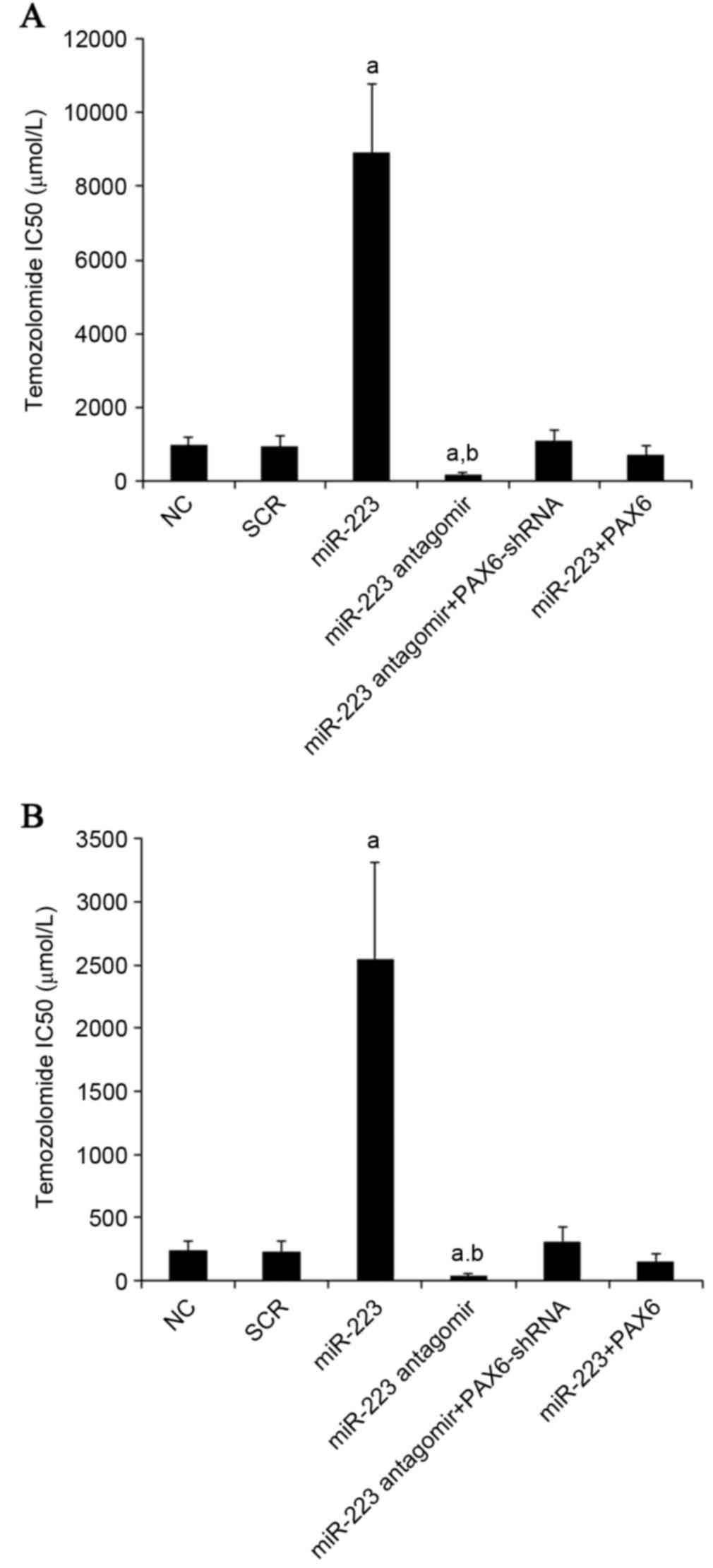Role of miR-223/paired box 6 signaling in temozolomide chemoresistance in glioblastoma multiforme cells
- Authors:
- Published online on: December 27, 2016 https://doi.org/10.3892/mmr.2016.6078
- Pages: 597-604
-
Copyright: © Cheng et al. This is an open access article distributed under the terms of Creative Commons Attribution License.
Abstract
Introduction
Glioblastoma multiforme (GBM) is the most malignant type of primary adult brain tumor (1). Patients with GBMs have a median survival of only 12–15 months (2). Surgery with maximum feasible resection, radiotherapy and treatment with alkylating agent temozolomide (TMZ) are standard treatments for GBM (3). The rapid growth and high rate of recurrence of GBM make surgical resection non-curative and leads to poor prognosis of this disease (4). Although TMZ has been identified to improve the survival rates of patients with GBM, a majority experience disease progression within one year (3). Therefore, it is important to identify ways to promote the efficacy of TMZ for GBM.
Paired box 6 (PAX6), a transcription factor critical for the development of the brain, is additionally expressed in the adult brain (5). Previous studies have demonstrated that PAX6 functions as a tumor suppressor that markedly limits the growth of GBM cells (6). The expression level of PAX6 reportedly is inversely correlated with the tumorigenicity and invasion of GBM cell lines and is significantly reduced in GBMs (7,8).
MicroRNAs (miRNAs) are small non-coding RNA molecules (containing ~22 nucleotides) that function in RNA silencing and post-transcriptional regulation of gene expression. miRNAs normally cleave mRNA by base-pairing to the 3′-untranslated region (UTR) of the target genes (9). Previously, it has been identified that miRNAs are involved in the progression and chemoresistance of numerous types of cancer, including GBM (10,11). Previous studies have suggested that miRNAs may be important regulators of the therapeutic efficacy of TMZ for GBMs (12–14).
The present study aimed to investigate the potential interaction among TMZ, PAX6 and miRNAs in GBM cells and assess its impact on GBM cell proliferation for, to the best of our knowledge, the first time.
Materials and methods
Cells lines and reagents
U251 and U118 human GBM cell lines were purchased from the Cell Center of Peking Union Medical University (Beijing, China) and American Type Culture Collection (ATCC; Manassas, VA, USA), respectively. Human PAX6-short hairpin RNA (shRNA) plasmid (sc-36195-SH), control shRNA plasmid (sc-108060), mouse monoclonal anti-PAX6 (AD2, 35) (sc-53108) and mouse monoclonal anti-β-actin (C4) (sc-47778) antibodies were purchased from Santa Cruz Biotechnology, Inc. (Santa Cruz, CA, USA). miR-223 mimic and miR-223 antagomir [a 20-O-methyl (20-OMe) modified antisense oligonucleotide 5′-GGGGUAUUUGACAAACUGACA-3′] were purchased from Shanghai GenePharma Co., Ltd. (Shanghai, China). Lipofectamine 2000 transfection reagent was purchased from Life Technologies (Thermo Fisher Scientific, Inc., Waltham, MA, USA). The bromodeoxyuridine (BrdU) Cell Proliferation ELISA kit (colorimetric; ab126556) was purchased from Abcam (Cambridge, MA, USA) and the dual-luciferase reporter assay system was purchased from Promega Corp. (Madison, WI, USA). Human full length PAX6 cDNA clone (SC109551) was purchased from OriGene Technologies, Inc. (Beijing, China) and subcloned into pcDNA 3.1 expression vector (Life Technologies; Thermo Fisher Scientific, Inc.). The PAX6-3′UTR-luciferase reporter was generated by subcloning human PAX6 3′-UTR into the psiCheck2 vector (Promega Corp.) downstream of the Renilla luciferase gene. miRNAs potentially able to suppress PAX6 expression were selected using TargetScan prediction software version 6.0 (www.targetscan.org). TMZ and all chemicals of reagent grade were purchased from Sigma-Aldrich (Merck Millipore, Darmstadt, Germany). TMZ was dissolved in dimethyl sulfoxide at a stock concentration of 100 mM and stored at −20°C.
Transfection
Plasmids, miR-223 mimic and antagomir were respectively transfected into cells using Lipofectamine 2000 transfection reagent (Life Technologies; Thermo Fisher Scientific, Inc.) according to the manufacturer's instructions. The cells were subject to analysis 48 h after transfection.
Western blot analysis
Cells were lysed with a hypotonic buffer containing 2% Nonidet-P and a protease inhibitor cocktail (Sigma-Aldrich; Merck Millipore) by sonication three times for 3 sec on ice. The supernatant obtained after centrifugation at 2,000 × g for 15 min at 4°C was used for protein concentration determination by the Coomassie blue method and for subsequent steps. Equal amounts of protein (5 µg) for each sample were separated using a 10% SDS-polyacrylamide gel and blotted onto a polyvinylidene difluoride microporous membrane (EMD Millipore, Billerica, MA, USA). Membranes were incubated for 1 h at room temperature with a 1:1,000 dilution of the primary antibody and then washed and revealed using incubation with bovine anti-mouse secondary antibody conjugated with horseradish peroxidase conjugate (1:5,000; Santa Cruz Biotechnology, Inc.; cat. no. sc-2371) at room temperature for 1 h. Peroxidase was observed using a GE Healthcare ECL kit (RPN2235; GE Healthcare Life Sciences, Shanghai, China). Three independent experiments were performed.
Reverse transcription-quantitative polymerase chain reaction (RT-qPCR)
RNA was prepared from cells using TRIzol reagent and cDNAs were synthesized using SuperScript II reverse transcriptase (Invitrogen; Thermo Fisher Scientific, Inc.). RT-qPCR was performed on an ABI-Prism 7700 Sequence Detection system, with use of the fluorescent dye SYBR-Green Master Mix (Applied Biosystems, Thermo Fisher Scientific, Inc., Beijing, China) as described by the manufacturer. The results were normalized against that of the reference gene glyceraldehyde-3-phosphate dehydrogenase (GAPDH) in the same sample. The primers used were as follows: Human PAX6, 5′-AGACACAGCCCTCACAAAC-3′ (forward) and 5′-ATCATAACTCCGCCCATTC-3′ (reverse); human GAPDH, 5′-GACTCATGACCACAGTCCATGC-3′ (forward) and 5′-AGAGGCAGGGATGATGTTCTG-3′ (reverse). The PCR reaction mixture contained 12.5 µl SYBR-Green Master Mix (Thermo Fisher Scientific, Inc.), 500 ng template cDNA, forward and reverse primers (0.25 µM each) and 12 µl nuclease-free water (Thermo Fisher Scientific, Inc.). The thermocycling conditions were as follows: 20 sec at 95°C; followed by 40 cycles of 5 sec at 95°C and 30 sec at 60°C. Each experiment was repeated three times in duplicate.
Luciferase assay
Cells were transfected with the human PAX6-3′UTR-luciferase reporter plasmid using Lipofectamine 2000 transfection reagent (Life Technologies; Thermo Fisher Scientific, Inc.) and then cultured for 48 h. Luciferase assays were performed with the Dual-Luciferase Reporter Assay system (Promega Corp.) according to the manufacturer's instructions. Each experiment was repeated three times in duplicate.
BrdU cell proliferation assay
Cells were cultured at 2×105 cells per well in 96-well tissue culture plates and treated with TMZ (400 µmol/l) for 48 h at 37°C. Cell proliferation was measured at 48 h with a colorimetric BrdU Cell Proliferation ELISA kit (Abcam) (15,16). BrdU was added 4 h before the end of the incubation period. The cells were then fixed, the DNA was denatured, and BrdU content was assessed using a monoclonal anti-BrdU antibody following the manufacturer's instructions (Abcam). Cell proliferation was presented as the optical density values at 450 nm. Each experiment was repeated three times in duplicate.
TMZ chemosensitivity assay
Cells were plated in duplicate in 96-well plates at a density of 5,000 cells per well. Transfection of plasmids, miR-223 mimic and antagomir were performed 6 h later. After 24 h of incubation, the medium was replaced by fresh medium with or without various concentrations (0.1, 0.15, 0.20, 0.25, 0.3, 0.5, 1.0, 1.5, 3.0, 6.0 or 15.0 mM) of TMZ (Sigma-Aldrich; Merck Millipore). Then cell viability was assayed 72 h later using a modified MTT assay as previously described (17). The half maximal inhibitory concentration (IC50) values were defined as the concentrations resulting in a 50% reduction in growth compared with control cell growth.
Statistical analysis
Statistical analyses were performed with SPSS for Windows, version 10.0 (SPSS Inc., Chicago, IL, USA). All data values were expressed as the mean ± standard deviation. Comparisons of the means among multiple groups were performed with one-way analysis of variance followed by post hoc pairwise comparisons using Tukey's tests. A two-tailed P<0.05 was considered to indicate a statistically significant difference.
Results
TMZ induces expression of PAX6 in GBM cells
To examine the effect of TMZ on the expression of PAX6 in GBM cells, human U251 and U118 GBM cells were treated with TMZ in increasing concentrations (100, 200 or 400 µM) for 48 h. As presented in Fig. 1, TMZ in the concentration range of 100–400 µM increasingly augmented the protein and mRNA levels of PAX6 in U251 and U118 cells within 48 h of treatment. The results indicate that TMZ induces the expression of PAX6 in GBM cells.
PAX6 is critical for the inhibitory effect of TMZ on GBM cell proliferation
To explore the functional role of PAX6 in the inhibitory effect of TMZ on GBM cell proliferation, PAX6 was overexpressed and knocked down in U251 and U118 cells. As presented in Fig. 2, transfection of the cells with a PAX6 expression vector increased the protein level of PAX6 by ~2.4-fold in U251 cells and 4.7-fold in U118 cells. On the other hand, transfection of the cells with PAX6-shRNA plasmids knocked down the protein level of PAX6 by ~60% in U251 cells and 70% in U118 cells. The proliferation of U251 and U118 cells with or without TMZ (400 µM) treatment was measured after this. BrdU cell proliferation assays demonstrated that 48 h of TMZ treatment significantly inhibited GBM cell proliferation in both U251 and U118 cells (Fig. 3). Overexpression of PAX6 increased the inhibitory effect of TMZ on GBM cell proliferation; on the other hand, knockdown of PAX6 abolished the inhibitory effect of TMZ on GBM cell proliferation (Fig. 3). The results suggest that PAX6 is an essential mediator of the inhibitory effect of TMZ on GBM cell proliferation.
TMZ inhibits expression of miR-223, which targets PAX6 in GBM cells
Next the TargetScan prediction software was employed to analyze the 3′-UTR of the PAX6 gene, which revealed that miR-223, miR-590-3p, miR-190, miR-190b and miR-7 would be most likely to target PAX6. As presented in Fig. 4A, TMZ (100–400 µM) concentration-dependently reduced the expression of miR-223 in U251 and U118 cells in a concentration-dependent manner within 48 h of treatment. Compared with that of miR-223, the expression levels of miR-590-3p, miR-190, miR-190b and miR-7 were not as significantly regulated by TMZ in GBM cells (data not shown). Thus, the interaction among TMZ, PAX6 and miR-223 in GBM cells was further explored. To demonstrate a direct interaction between miR-223 and PAX6, the 3′-UTR of the PAX6 gene was inserted downstream of the Renilla luciferase gene in the psiCheck2 vector to generate a wild type (wt)-PAX6-3′UTR-luciferase reporter. Meanwhile, the potential binding sequence for miR-223 in the 3′-UTR of the PAX6 gene, as predicted by TargetScan, was mutated to generate a mut-PAX6-3′UTR-luciferase reporter (Fig. 4B). U251 and U118 cells were co-transfected with miR-223 mimic or antagomir together with either the wt-PAX6-3′UTR-luciferase reporter or the mut-PAX6-luciferase reporter. As presented in Fig. 4C and D, compared with the scrambled control, miR-223 mimic and antagomir decreased and increased the luciferase activity of the wt-PAX6-3′UTR respectively, however did not affect that of the mut-PAX6-3′UTR reporter. This suggests that miR-223 could suppress the expression of PAX6 by directly binding to the 3′-UTR of the PAX6 gene. RT-qPCR assays demonstrated that miR-223 mimic and antagomir decreased and increased the mRNA levels of PAX6, respectively, in U251 and U118 cells (Fig. 5), confirming that miR-223 targets PAX6 in GBM cells.
TMZ/miR-223 signaling inhibits GBM cell proliferation through inducing expression of PAX6
The above observations indicate that TMZ inhibits the expression of miR-223, which targets PAX6 in GBM cells. To explore the effect of TMZ/miR-223/PAX6 signaling on GBM cell proliferation, it was first examined how TMZ/miR-223 signaling would regulate the expression of PAX6 in GBM cells. In the absence of TMZ treatment, compared with scrambled control, miR-223 mimic decreased the expression of PAX6 by approximately 60% in U251 cells and 70% in U118 cells, while miR-223 antagomir increased the expression of PAX by approximately 2.1-fold in U251 cells and 2.7-folds in U118 cells (Fig. 6). In the presence of TMZ treatment (400 µM for 48 h), compared with scrambled control, miR-223 mimic decreased the expression of PAX6 by approximately 45% in U251 cells and 75% in U118 cells, while miR-223 antagomir increased the expression of PAX by approximately 2.5-fold in U251 cells and 3.5-fold in U118 cells (Fig. 6). Regardless of TMZ treatment, overexpression and knockdown of PAX6 respectively abolished the effects of miR-223 mimic and antagomir (Fig. 6). In the presence of TMZ treatment (400 µM for 48 h), compared with the controls, miR-223 mimic increased proliferation by approximately 1.3-fold in U251 cells and 1.6-fold in U118 cells, while miR-223 antagomir decreased proliferation by approximately 30% in U251 cells and 43% in U118 cells (Fig. 7). Overexpression and knockdown of PAX6, respectively, abolished the effects of miR-223 mimic and antagomir (Fig. 7).
Inhibition of miR-223/PAX6 signaling increases TMZ chemoresistance in GBM cells
To explore the effect of inhibition of miR-223/PAX6 signaling on TMZ chemoresistance in GBM cells, TMZ IC50 values were examined. A higher IC50 value was considered to correspond with clinical chemoresistance to TMZ. U251 and U118 GBM cells were plated in 96-well plates. Transfection of plasmids, miR-223 mimic and antagomir were performed 6 h later. After 24 h of incubation, the medium was replaced by fresh medium with or without various concentrations of TMZ, and cell viability was assayed 72 h later. As presented in Fig. 8, the TMZ IC50 values in U251 and U118 cells were 240 and 970 µM, respectively; miR-223 mimics increased the TMZ IC50 to 2,549 and 8,900 µM, respectively, which was abolished by overexpression of PAX6. On the other hand, inhibiting miR-223 with antagomir decreased TMZ IC50 to 45 and 170 µM in U251 and U118 cells, respectively, which was abolished by knockdown of PAX6 (Fig. 8).
Discussion
GBM is a fatal adult brain tumor (18), and the prognosis of GBM remains poor despite advances in surgery, chemotherapy and radiotherapy (2,4). It is common that patients with GBM show innate or acquired resistance to TMZ, a standard chemotherapeutic agent for GBM (3). PAX6 is reported as an independent prognostic marker for GBM (5). There is accumulating evidence that PAX6 functions as a tumor suppressor and suppresses growth of GBM cells (6). A recent study has demonstrated that miR-223 promotes the growth and invasion of GBM cells by targeting PAX6 (8). The present study confirms that miR-223 directly targets PAX6 in GBM cells. Nevertheless, the highlight of the present study is providing the first evidence that TMZ inhibits the proliferation of GBM cells by increasing the expression of PAX6 through inhibiting miR-223. In addition, it demonstrates that inhibiting miR-223 can markedly decrease TMZ chemoresistance in GBM cells, suggesting that miR-223/PAX6 signaling could be a potential target for overcoming TMZ chemoresistance in GBM.
In the present study, two GBM cell lines (U251 and U118) were used as the cell models. In both cell lines, TMZ concentration-dependently decreased the expression of miR-223, which led to increased expression of PAX6 and decreased proliferation of GBM cells. The TMZ/miR-223/PAX signaling axis provides novel insight into the pharmacological mechanisms of TMZ. The molecular mechanism underlying TMZ-induced inhibition of miR-223 requires further investigation.
TMZ IC50 was employed as a measure of TMZ chemoresistance in GBM cells. An increased IC50 was considered to correspond with clinical chemoresistance to TMZ. Overexpression and inhibition of miR-223, respectively, decreased and increased the expression of PAX6, which markedly altered TMZ IC50 by ~1 order of magnitude in GBM cells. In the presence of TMZ, miR-223 antagomir significantly enhanced TMZ-induced inhibition on GBM cell proliferation and decreased TMZ chemoresistance, suggesting that inhibition of miR-223 may be a potential novel strategy to enhance the therapeutic effects of TMZ on GBM. The effects of miR-223 antagomir was respectively abolished and enhanced by knockdown and overexpression of PAX6, confirming that miR-223 promotes GBM resistance to TMZ predominantly by downregulating PAX6, or miR-223 antagomir decreases TMZ chemoresistance by upregulating PAX6.
miR-223 is a highly conserved miRNA, that was originally identified to be crucial for myeloid differentiation of progenitor cells (19). The expression levels of miR-223 are reportedly decreased in chronic lymphocytic leukemia (CLL) and could predict treatment-free survival and overall survival for CLL (20). It is also commonly repressed in hepatocellular carcinoma (21). A previous study has demonstrated that miR-223 inhibits non-small cell lung cancer cell proliferation and invasion, suggesting that it functions as a tumor suppressor (22). On the other hand, miR-223 is upregulated in bladder cancer (23) and esophageal squamous cell carcinoma (24), and it has been identified to promote tumor cell proliferation and invasion in gastric cancer and GBM (8,25). In this study, it is demonstrated that miR-223 antagonizes the inhibitory effects of TMZ on GBM cells by inhibiting the expression of PAX6. Taken together, the observations suggest that miR-223 likely serves a dual role in cancer malignancy and chemoresistance, depending on tissue specificity, and possibly, tissue-specific expression of PAX6. Due to the fact that PAX6 is expressed in the eye, brain and pancreas in healthy adults (5), the exploration of the role of miR-223/PAX6 signaling in the pathogenesis and chemoresistance of retinoblastoma and pancreatic cancer besides GBM may be beneficial.
Similar to that of several other solid tumor types, GBM is considered to be driven by a small sub-population of cells known as glioma stem cells (26). miR-223 reportedly functions as an essential regulator of human embryonic stem cell differentiation (27). Previous studies have indicated that PAX6 serves an important role in maintaining retinal stem cell properties (28) and is overexpressed in cancer stem-like cells in retinoblastoma (29), suggesting that PAX6 may be closely involved in maintenance of cancer stem cells. Thus, the examination of the role of miR-223/PAX6 signaling in the biology and chemoresistance of glioma stem cells may be beneficial in future studies.
In conclusion, the present study demonstrates that TMZ inhibits GBM cell proliferation by inhibiting the expression of miR-223, which leads to increased expression of tumor suppressor PAX6. While overexpression of miR-223 increases TMZ chemoresistance, inhibition of miR-223 with antagomir markedly decreases TMZ chemoresistance in GBM cells. The present study provides novel insight into the molecular mechanisms underlying the pharmacological effects and chemoresistance of TMZ for GBM.
References
|
Zhang Z and Lin CC: Taking advantage of neural development to treat glioblastoma. Eur J Neurosci. 40:2859–2866. 2014. View Article : Google Scholar : PubMed/NCBI | |
|
Wen PY and Kesari S: Malignant gliomas in adults. N Engl J Med. 359:492–507. 2008. View Article : Google Scholar : PubMed/NCBI | |
|
van den Bent MJ, Hegi ME and Stupp R: Recent developments in the use of chemotherapy in brain tumours. Eur J Cancer. 42:582–588. 2006. View Article : Google Scholar : PubMed/NCBI | |
|
Giese A, Bjerkvig R, Berens ME and Westphal M: Cost of migration: Invasion of malignant gliomas and implications for treatment. J Clin Oncol. 21:1624–1636. 2003. View Article : Google Scholar : PubMed/NCBI | |
|
Zhou YH, Tan F, Hess KR and Yung WK: The expression of PAX6, PTEN, vascular endothelial growth factor, and epidermal growth factor receptor in gliomas: Relationship to tumor grade and survival. Clin Cancer Res. 9:3369–3375. 2003.PubMed/NCBI | |
|
Zhou YH, Wu X, Tan F, Shi YX, Glass T, Liu TJ, Wathen K, Hess KR, Gumin J, Lang F and Yung WK: PAX6 suppresses growth of human glioblastoma cells. J Neurooncol. 71:223–229. 2005. View Article : Google Scholar : PubMed/NCBI | |
|
Mayes DA, Hu Y, Teng Y, Siegel E, Wu X, Panda K, Tan F, Yung WK and Zhou YH: PAX6 suppresses the invasiveness of glioblastoma cells and the expression of the matrix metalloproteinase-2 gene. Cancer Res. 66:9809–9817. 2006. View Article : Google Scholar : PubMed/NCBI | |
|
Huang BS, Luo QZ, Han Y, Li XB, Cao LJ and Wu LX: microRNA-223 promotes the growth and invasion of glioblastoma cells by targeting tumor suppressor PAX6. Oncol Rep. 30:2263–2269. 2013.PubMed/NCBI | |
|
Ma R, Jiang T and Kang X: Circulating microRNAs in cancer: Origin, function and application. J Exp Clin Cancer Res. 31:382012. View Article : Google Scholar : PubMed/NCBI | |
|
Jones KB, Salah Z, Del Mare S, Galasso M, Gaudio E, Nuovo GJ, Lovat F, LeBlanc K, Palatini J, Randall RL, et al: miRNA signatures associate with pathogenesis and progression of osteosarcoma. Cancer Res. 72:1865–1877. 2012. View Article : Google Scholar : PubMed/NCBI | |
|
Hermansen SK and Kristensen BW: MicroRNA biomarkers in glioblastoma. J Neurooncol. 114:13–23. 2013. View Article : Google Scholar : PubMed/NCBI | |
|
Shi L, Chen J, Yang J, Pan T, Zhang S and Wang Z: MiR-21 protected human glioblastoma U87MG cells from chemotherapeutic drug temozolomide induced apoptosis by decreasing Bax/Bcl-2 ratio and caspase-3 activity. Brain Res. 1352:255–264. 2010. View Article : Google Scholar : PubMed/NCBI | |
|
Zhang S, Wan Y, Pan T, Gu X, Qian C, Sun G, Sun L, Xiang Y, Wang Z and Shi L: MicroRNA-21 inhibitor sensitizes human glioblastoma U251 stem cells to chemotherapeutic drug temozolomide. J Mol Neurosci. 47:346–356. 2012. View Article : Google Scholar : PubMed/NCBI | |
|
Wang J, Sai K, Chen FR and Chen ZP: miR-181b modulates glioma cell sensitivity to temozolomide by targeting MEK1. Cancer Chemother Pharmacol. 72:147–158. 2013. View Article : Google Scholar : PubMed/NCBI | |
|
Mesti T, Savarin P, Triba MN, Le Moyec L, Ocvirk J, Banissi C and Carpentier AF: Metabolic impact of anti-angiogenic agents on U87 glioma cells. PLoS One. 9:e991982014. View Article : Google Scholar : PubMed/NCBI | |
|
Olivares S, Green RM and Henkel AS: Endoplasmic reticulum stress activates the hepatic activator protein 1 complex via mitogen activated protein kinase-dependent signaling pathways. PLoS One. 9:e1038282014. View Article : Google Scholar : PubMed/NCBI | |
|
Ding X, Zhang Z, Li S and Wang A: Combretastatin A4 phosphate induces programmed cell death in vascular endothelial cells. Oncol Res. 19:303–309. 2011. View Article : Google Scholar : PubMed/NCBI | |
|
Louis DN, Ohgaki H, Wiestler OD, Cavenee WK, Burger PC, Jouvet A, Scheithauer BW and Kleihues P: The 2007 WHO classification of tumours of the central nervous system. Acta Neuropathol. 114:97–109. 2007. View Article : Google Scholar : PubMed/NCBI | |
|
Fazi F, Rosa A, Fatica A, Gelmetti V, De Marchis ML, Nervi C and Bozzoni I: A minicircuitry comprised of microRNA-223 and transcription factors NFI-A and C/EBPalpha regulates human granulopoiesis. Cell. 123:819–831. 2005. View Article : Google Scholar : PubMed/NCBI | |
|
Stamatopoulos B, Meuleman N, Haibe-Kains B, Saussoy P, Van Den Neste E, Michaux L, Heimann P, Martiat P, Bron D and Lagneaux L: microRNA-29c and microRNA-223 down-regulation has in vivo significance in chronic lymphocytic leukemia and improves disease risk stratification. Blood. 113:5237–5245. 2009. View Article : Google Scholar : PubMed/NCBI | |
|
Wong QW, Lung RW, Law PT, Lai PB, Chan KY, To KF and Wong N: MicroRNA-223 is commonly repressed in hepatocellular carcinoma and potentiates expression of Stathmin1. Gastroenterology. 135:257–269. 2008. View Article : Google Scholar : PubMed/NCBI | |
|
Nian W, Ao X, Wu Y, Huang Y, Shao J, Chen Z, Chen F and Wang D: miR-223 functions as a potent tumor suppressor of the Lewis lung carcinoma cell line by targeting insulin-like growth factor-1 receptor and cyclin-dependent kinase 2. Oncol Lett. 6:359–366. 2013.PubMed/NCBI | |
|
Gottardo F, Liu CG, Ferracin M, Calin GA, Fassan M, Bassi P, Sevignani C, Byrne D, Negrini M, Pagano F, et al: Micro-RNA profiling in kidney and bladder cancers. Urol Oncol. 25:387–392. 2007. View Article : Google Scholar : PubMed/NCBI | |
|
Kurashige J, Watanabe M, Iwatsuki M, Kinoshita K, Saito S, Hiyoshi Y, Kamohara H, Baba Y, Mimori K and Baba H: Overexpression of microRNA-223 regulates the ubiquitin ligase FBXW7 in oesophageal squamous cell carcinoma. Br J Cancer. 106:182–188. 2012. View Article : Google Scholar : PubMed/NCBI | |
|
Li X, Zhang Y, Zhang H, Liu X, Gong T, Li M, Sun L, Ji G, Shi Y, Han Z, et al: miRNA-223 promotes gastric cancer invasion and metastasis by targeting tumor suppressor EPB41L3. Mol Cancer Res. 9:824–833. 2011. View Article : Google Scholar : PubMed/NCBI | |
|
Singh SK, Hawkins C, Clarke ID, Squire JA, Bayani J, Hide T, Henkelman RM, Cusimano MD and Dirks PB: Identification of human brain tumour initiating cells. Nature. 432:396–401. 2004. View Article : Google Scholar : PubMed/NCBI | |
|
Yu YH, Zhang L, Wu DS, Zhang Z, Huang FF, Zhang J, Chen XP, Liang DS, Zeng H and Chen FP: MiR-223 regulates human embryonic stem cell differentiation by targeting the IGF-1R/Akt signaling pathway. PLoS One. 8:e787692013. View Article : Google Scholar : PubMed/NCBI | |
|
Bhattacharya S, Das A, Mallya K and Ahmad I: Maintenance of retinal stem cells by Abcg2 is regulated by notch signaling. J Cell Sci. 120:2652–2662. 2007. View Article : Google Scholar : PubMed/NCBI | |
|
Ma B, Lei X, Guan Y, Mou LS, Yuan YF, Yue H, Lu Y, Xu GT and Qian J: Maintenance of retinal cancer stem cell-like properties through long-term serum-free culture from human retinoblastoma. Oncol Rep. 26:135–143. 2011.PubMed/NCBI |



